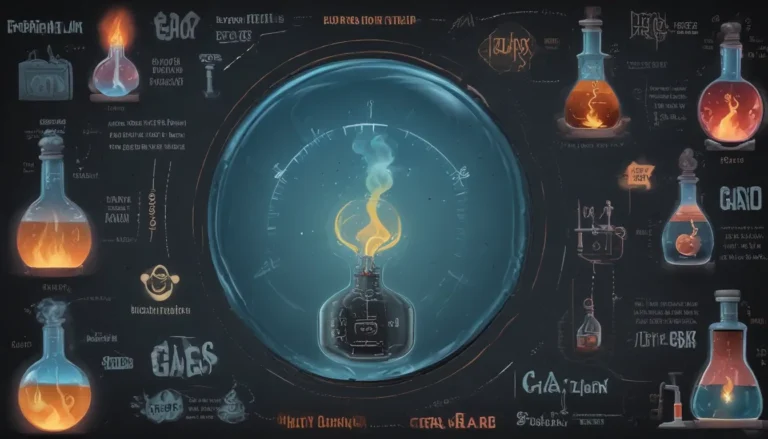A Note About Images: The images used in our articles are for illustration purposes only and may not exactly match the content. They are meant to engage readers, but the text should be relied upon for accurate information.
Chemical reactions are the driving force behind the transformations and phenomena we observe in the world around us. Understanding how reactions progress towards equilibrium is crucial for scientists studying these processes. One key concept that plays a significant role in this understanding is the reaction quotient (Q). In this article, we will delve into the intricate world of reaction quotient, exploring its definition, calculation, relationship with equilibrium constants, and its importance in predicting the direction of reactions. Join us on an enlightening journey as we uncover 13 enigmatic facts about reaction quotient and its profound significance in the realm of chemical equilibrium.
Unraveling the Mystery of Reaction Quotient (Q)
At the core of chemical reactions lies the reaction quotient (Q), a fundamental mathematical expression that reveals the relative concentrations of reactants and products at any given moment during a reaction. By analyzing Q, scientists can determine whether a reaction is at equilibrium or if it will proceed towards the formation of more products or reactants.
Differentiating Q from K – A Crucial Distinction
While both Q and the equilibrium constant (K) involve concentrations of reactants and products, they serve distinct purposes. K describes concentrations at equilibrium, while Q provides insight into concentrations at any point during a reaction. When Q equals K, the reaction is at equilibrium, indicating a balanced state.
The Interplay Between Q and the Direction of Reaction
Comparing Q to K offers valuable insights into the direction a reaction will take. If Q surpasses K, the reaction will shift towards the reactants, aiming to establish equilibrium. Conversely, if Q falls short of K, the reaction will favor the products, seeking equilibrium through this shift.
Navigating the Calculation of Q
To determine Q, the same formula utilized for calculating the equilibrium constant is employed. However, instead of relying on equilibrium concentrations, Q considers concentrations of reactants and products at specific moments throughout the reaction.
Harnessing Q to Predict Reaction Shifts
By evaluating Q vis-à-vis K, scientists can foresee the direction in which a reaction will progress to attain equilibrium. A greater Q than K prompts a shift towards the reactants, while a lesser Q than K signals a movement towards the products.
The Impact of Pressure and Temperature Changes on Q
Modifications in pressure and temperature within a system can influence both Q and the direction of a reaction. Altering pressure typically favors the side with fewer gas moles, while variations in temperature can sway the equilibrium towards products or reactants, contingent on whether the reaction is exothermic or endothermic.
Shedding Light on Catalysts and Their Role in Q
Catalysts, although instrumental in expediting reactions by lowering activation energy, do not alter the value of Q. Instead, they provide alternative reaction pathways, facilitating the rate at which equilibrium is achieved.
Embracing Dynamic Equilibrium – Where Q Equals K
Dynamic equilibrium is attained when Q aligns with K, signifying a state where the rates of forward and reverse reactions are on par. Throughout this equilibrium, the concentrations of reactants and products remain steady, maintaining a delicate balance.
FAQs
- What is the reaction quotient (Q)?
The reaction quotient (Q) signifies the relative concentrations of products and reactants in a chemical reaction at a specific moment. - How is the reaction quotient (Q) calculated?
Q is computed by substituting reactant and product concentrations into the equilibrium expression, akin to calculating the equilibrium constant (K). - How is the direction of a reaction determined using Q?
If Q exceeds K, the reaction progresses towards the reactants; if Q is less than K, the reaction favors the products. Equilibrium is achieved when Q equals K. - Can Q change?
Indeed, Q fluctuates as concentrations evolve over time. It can be recalculated as the system reaches new concentration sets. - What factors influence the value of Q?
Temperature, pressure, and concentrations of reactants and products can all impact the value of Q.
In conclusion, unraveling the mysteries of reaction quotient (Q) offers profound insights into the dynamics of chemical reactions. By comprehending and leveraging Q, chemists can steer reactions towards desired outcomes, whether in the realm of pharmaceuticals, materials science, or environmental chemistry. So, as you encounter chemical reactions in your explorations, remember the enigmatic nature of the reaction quotient (Q) and embrace its significance in unraveling the complexities of chemical systems. Let the journey into the realm of reaction quotient ignite your curiosity and deepen your understanding of the intricate world of chemical equilibrium.






